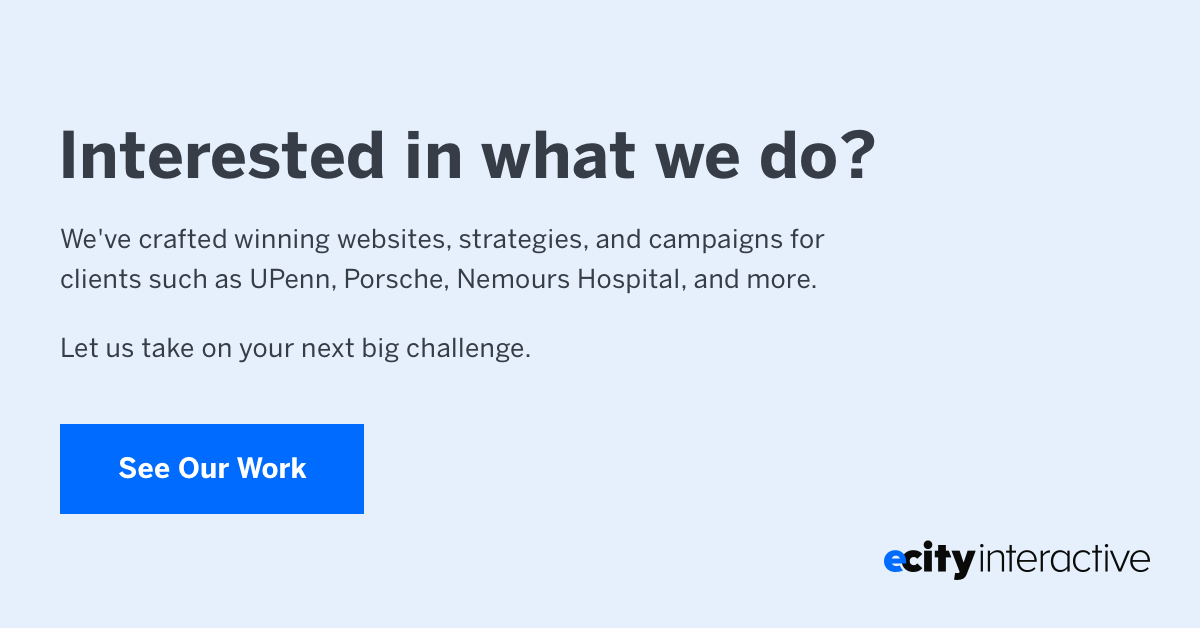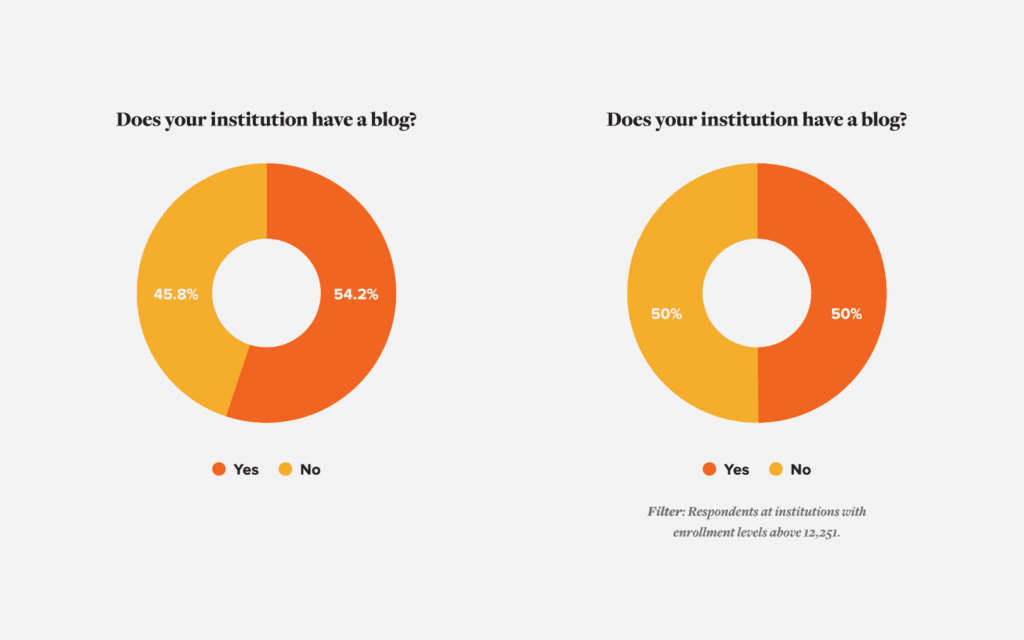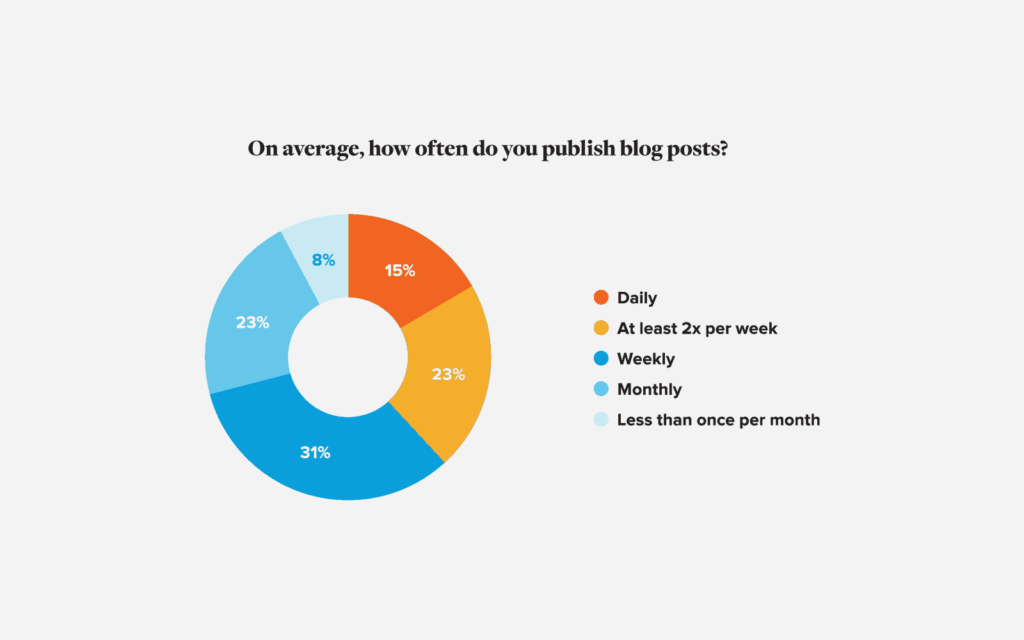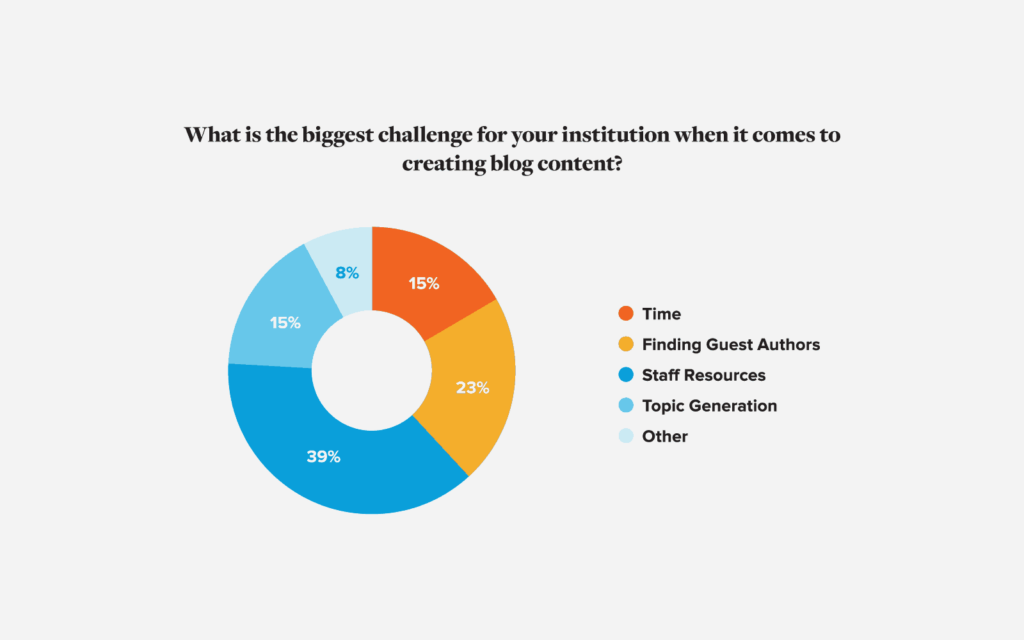Several months ago, we at eCity embarked on a mission to learn the state of digital marketing in higher education. Higher education, as an industry, is incredibly diverse; each institution has its own mission, target audience, strengths, and weaknesses. The same holds true for marketing professionals in those institutions across the country. Marketing teams vary from teams of one to teams of many, with budgets large, small, and non-existent.
In an effort to understand how higher education professionals were approaching their marketing, we released a short survey, asking professionals for their input on blogging, social media, email marketing, and the other digital marketing tactics at their disposal, along with the challenges and goals in their departments and institutions as a whole. Then, to supplement our primary data, we combined our research with reports put together by Ruffalo-Noel Lovitz, Orbit Media, Higher Ed Experts, Social Media Examiner, and mStoner.
The takeaways from this exercise were enlightening on many levels, but perhaps no topic was more surprising to us than blogging. As a content-first digital agency, we’ve become blogging evangelists. And when you spend a large part of your day thinking about blogging, creating content, or reading other blogs, it’s easy to assume that everyone is blogging.
But in our survey results, we immediately noticed a sizable gap between those in higher education who blog and those who do not. Just over 50% (54.2%) of survey respondents reported that their institution had a blog. However, among those who reported blogging, 53% reported having six or more blogs. And among respondents who reported that their institution wasn’t blogging, over 90% stated that they were either unsure or did not plan on launching a blog in 2017.
Initially, we believed this was correlated to the size of the institution, but we found that respondents from schools and colleges with 12,251+ students were split evenly between institutions that blogged vs schools that did not.
Further proof of the blogging chasm is the rate at which schools are publishing. Among respondents who reported blogging, 68% reported publishing weekly, 2x weekly, or daily, while only 23% reported publishing monthly, and 7% less than once per month.
Respondents are either all in on blogging or not in at all.
The Case For Blogging
It’s not hard to see why some institutions would be all in on blogging. As audiences increasingly rely on Google, Bing, and other search engines to find the information they need, a healthy blog can strongly enhance a website’s findability with search engines and audiences alike. This is especially true concerning prospective college students, who are relying on search engines throughout the college admissions process like never before.
In a 2016 Ruffalo Noel-Levitz survey of college-bound high school juniors and seniors, search engines were overwhelmingly ranked as the most popular method for finding college websites, with 86% of college-bound seniors and 88% of college-bound juniors using search engines to find college websites. A benchmarking study by Karine Joly at Higher Ed Experts paints a similar study. In her examination of 8,000 worldwide higher ed websites using Google Analytics, organic search was overwhelmingly the top traffic share.
Those reports mirror results from Capture Higher Ed, which tracked 20 million unique web visitors last year on its clients’ sites, including the University of Pittsburgh, Syracuse University, and Colby College. The results, according to Vice President of Data Science Thomas Golden, were clear. “We found there is a significant amount of inbound traffic that’s organic,” said Golden in a 2017 interview with The Atlantic.
Today, prospective students are conducting more and more of their research online, without being contacted by campus admissions staffs or making an official inquiry. And without a consistent blogging strategy or substantial paid media approach, schools are missing an opportunity to earn themselves higher web traffic and identify valuable prospects earlier in the college search process.
The Case Against Blogging
Of course, there are reasons that nearly 50% of survey respondents reported that their institutions were not blogging. And first and foremost among those reasons: blogging takes a lot of work, and staff resources are thin for many higher education marketing teams.
Indeed, among respondents who reported blogging, staff resources was listed as their biggest challenge when creating blog content, with nearly 40% of respondents claiming the personnel problem as their main challenge. Other common challenges listed included finding guest authors (23%), time (15%), and topic generation (15%).
Blogging is also becoming more time consuming each year. In its 2016 State of Blogging report, Orbit Media found that the average blog post took 3 hours, 16 minutes to write. That figure represented a 26% increase from the year prior. Furthermore, twice as many bloggers reported spending 6+ hours on an average blog post. That type of time investment could easily be seen as cost prohibitive in an environment where staff resources are already stretched thin.
Reducing the Blogging Chasm
How can we improve the situation? The easiest solution would be to bring a full-time writer or editor into the fold. Doing so could give individual departments across campus a resource to assist in content generation and publishing, and help align each blog around more-focused goals, topics, and audiences. That seems unlikely for most marketing teams, however.
Another option: consider adopting new communication channels, like Slack or Microsoft Teams, which could help departments quickly communicate with each other around topic ideas and guest authors. Such a solution would address the challenge of finding guest authors and keeping up with various events and accomplishments across departments — two challenges frequently identified among respondents in our survey.
Finally, institutions could look externally for help. There are a number of reputable marketing agencies focused on higher education, ready and willing to assist institutions with marketing campaigns, web design, and content strategy and creation.
To learn more about the blogging chasm in higher education, as well as insights from higher education marketers on social media, email marketing, and future content plans, download our full State of Digital Marketing Report today.








